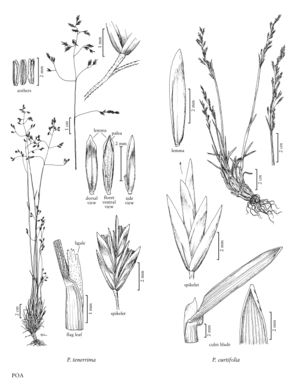Poa curtifolia
Plants perennial; densely tufted, not stoloniferous, not rhizomatous. Basal branching mainly intravaginal. Culms (15) 20-40 cm, erect or decumbent, with 1-2 exserted nodes. Sheaths closed for 1/5-1/3 their length, terete, smooth, bases of basal sheaths glabrous, distal sheath lengths 4-33 times blade lengths, smooth, glabrous; ligules (1.5) 2-5 mm, smooth or sparsely scabrous, margins distinctly decurrent, apices obtuse to acute, ligules of innovations prominent, milky white; innovation blades similar to the cauline blades; cauline blades gradually reduced in length upwards, (1) 1.5-3 mm wide, flat, thick, fairly firm, smooth or sparsely scabrous, margins white, apices broadly prow-shaped, flag leaf-blades 0.2-1.8 cm, infrequently absent. Panicles 4-8 cm, erect, linear to narrowly lanceoloid, contracted, moderately congested, with 9-35 spikelets; nodes with 1-2 branches; branches 1-2.5 cm, erect to steeply ascending, straight, sulcate or angled, angles sparsely to moderately scabrous, with 1-4 spikelets in the distal 1/2. Spikelets 7-9 mm, lengths 3.5-4 times widths, lanceolate, fairly compressed, pale, slightly lustrous; florets (2) 3-4; rachilla internodes 1-2 mm. Glumes lanceolate to broadly lanceolate, margins broadly scarious, keels indistinct, smooth or sparsely scabrous; lower glumes 3-veined, slightly to distinctly shorter than the lowest lemma; calluses glabrous; lemmas 4.5-6 mm, lanceolate, somewhat weakly keeled, glabrous or the keels, marginal veins, and intercostal regions very sparsely puberulent over the proximal 1/3, lateral-veins obscure, margins strongly inrolled proximally, broadly scarious distally, glabrous, apices acute; palea keels scabrous, glabrous or puberulent at midlength; anthers 2.2-3.5 mm. 2n = 42.
Discussion
Poa curtifolia is endemic to upper serpentine slopes in the Wenatchee Mountains, Kittitas and Chelan counties, "Washington. It has narrow panicles like P. pringlei (p. 564) and P. suksdorfii (p. 584). It differs from P. secunda (p. 586), with which it is sometimes confused, in having all blades short, flat, and firm, and few spikelets per branch.
Selected References
None.
Lower Taxa
"thin" is not a number."reduced" is not a number.No values specified."decumbent" is not a number.
